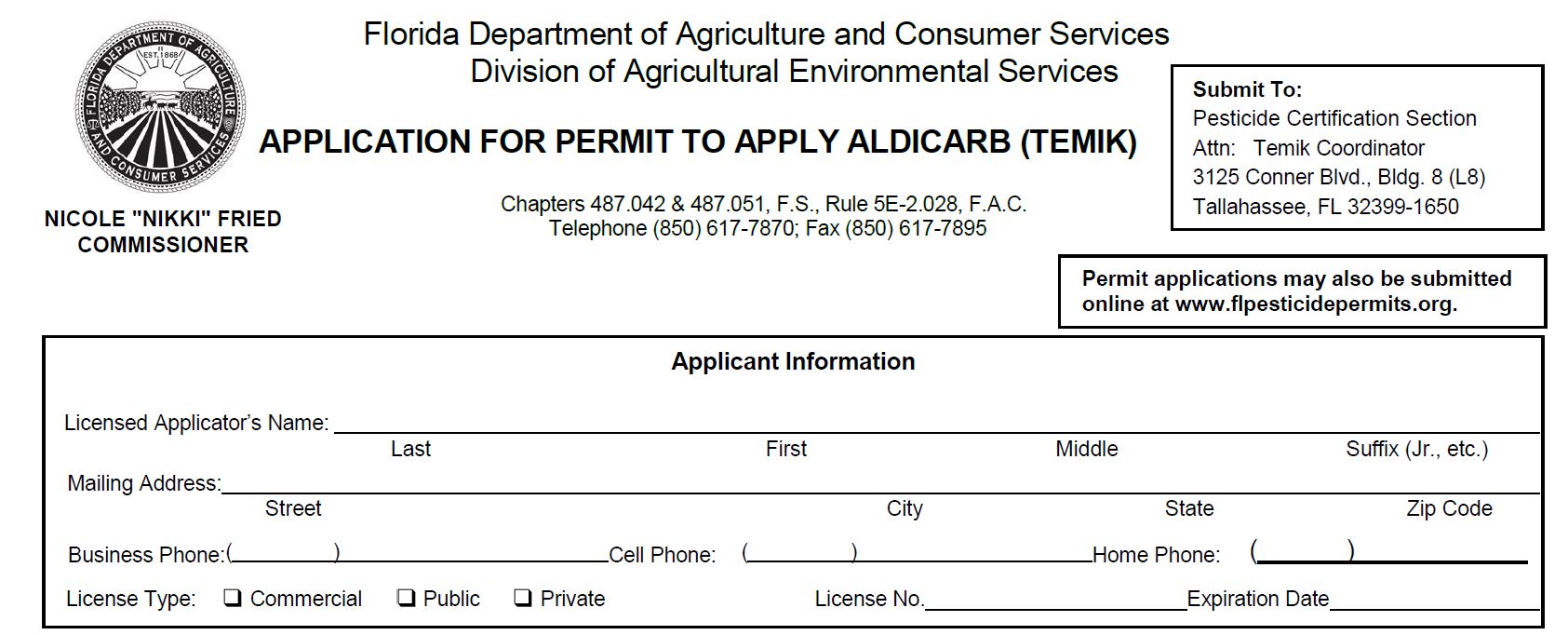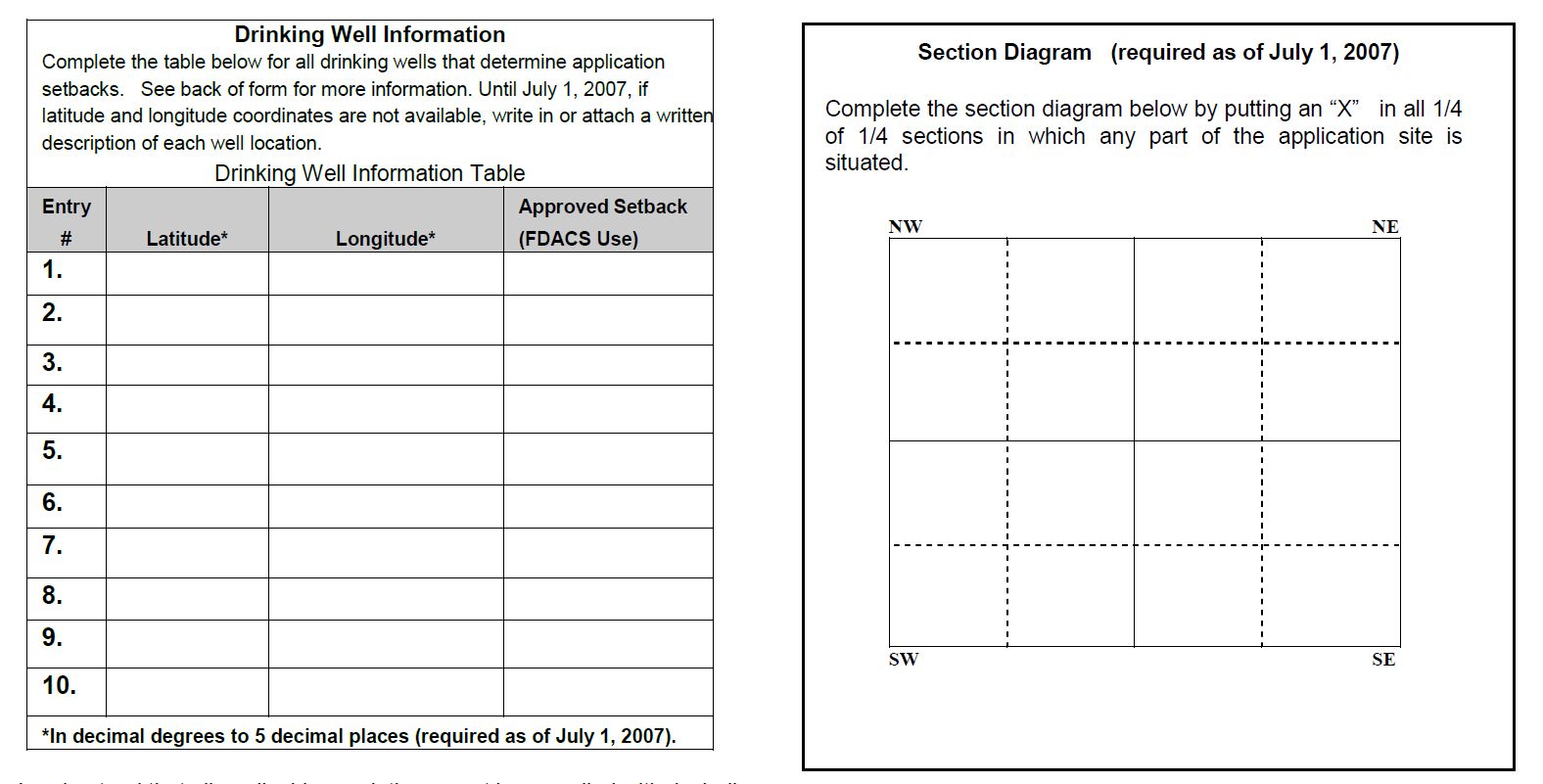The objectives of this publication are to guide growers, Extension agents, licensed applicators and other agricultural professionals through the process to obtain the permit required to legally apply aldicarb in Florida. As described in this publication, the label is the law, and this publication is not a substitute for state or federal law.
Pesticide application is a common tool for managing pests in agriculture production. Pesticides are subject to state and federal laws and regulations. Aldicarb is a pesticide that is subject to particular restrictions because of its highly toxic nature and concerns about groundwater contamination when aldicarb is not properly applied. Aldicarb is an insecticide/nematicide that is currently labeled only for cotton and peanut in Florida. AgLogic 15GG (gypsum formula) is the only product registered in Florida that contains aldicarb. It is manufactured by AgLogic Chemical Company LLC (Chapel Hill, NC). Aldicarb was also the active ingredient in Temik 15G, a product that is no longer registered but is still sometimes referenced in Florida’s Department of Agriculture and Consumer Services (FDACS) materials. Aldicarb, as specified on the label, is a restricted-use pesticide, and therefore applicators must have a current and valid private or commercial Florida pesticide applicator’s license with a row crop category designation. Additionally, applicators must obtain an aldicarb permit from FDACS before applying this product in Florida. Note that these requirements apply to out-of-state residents (i.e., people from Alabama or Georgia) who are farming land in Florida, but within the row crop category a valid Alabama or Georgia pesticide applicator’s license can be used to apply for a Florida license without additional testing or CEU documentation. In recent years, there have been questions about applying for this free permit, therefore this publication is intended to guide growers through the process.
How and when to Obtain an Aldicarb Application Permit Form
Applicators can obtain a permit application from this section of the FDACS website. The application is site-specific; one permit application must be filled out for every field where aldicarb will be applied. The permit cannot be transferred from one applicator to another. Growers are also required to complete stewardship training (https://www.aglogicchemical.com/stewardship) before purchasing and applying aldicarb. Growers should complete the short stewardship certificate before applying for the aldicarb permit. The application can be completed up to 6 months before the product is applied. The permit is not valid beyond 6 months, so a new permit application must be submitted each year. Growers are advised to submit for permits as early in the year as possible in case unforeseen delays in permit processing occur. Aldicarb can only be applied after the permit is approved, but seeking permit approval does not obligate growers to use aldicarb, it merely provides permission to apply aldicarb at the specified site. Many permit approval delays are due to incomplete or inaccurate permit applications, so complete the permit application completely and accurately to help speed approval. Published FDACS permit processing times of 3–5 business days are only an estimate of processing times for an accurate application. That estimate does not include time for field site visits, which are being done by the aldicarb manufacturer. Improper application of aldicarb, such as applying aldicarb without a permit, is subject to a fine of $10,000 per violation and restrictions on the pesticide applicator’s license.
Completing the Aldicarb Permit Application
The aldicarb permit application has sections on applicant information (Figure 1), aldicarb application site information, well information, and a section diagram of the application site. The applicant information section is relatively straightforward, but growers and applicators have had questions about the other sections in the past, so more detailed instructions for these sections follows. As described earlier, applicants must have a valid, current pesticide applicator license with a row crop designation and must provide the license number in the application. Florida pesticide applicator license details (category, license number, and expiration date) can be checked at this website. Page 2 of the permit application provides instructions for completing the permit, although not all details may be current.

Credit: FDACS
Providing Location Data in the Application
As shown in the Figure 2 screenshot, the “Site Information” section of the permit application asks for basic contact and location information. In particular, the township, range, and section for the application is requested. Be mindful of the order of this location information as this is a common error. Do not forget to select a crop (cotton and peanut are the only Florida crops currently labeled for aldicarb use), as this is another common error. Under “Field/Grove/Block,” list whatever name you call the field. Applicants must also mark all “1/4 of 1/4 sections” where aldicarb will be applied in the “Section Diagram” (Figure 3). In the past, growers have had questions about how to find township information for their application site. Your local county property appraiser’s office should be able to provide a map that includes this information. Many counties have these maps publicly available through their website (e.g. https://srcpa.gov/Map). In other counties, you may be able to request a physical map or obtain one by visiting the office in person. Free commercial online map tools are also available (e.g. randymajors.org).

Credit: FDACS
What wells do I list on the application?
The “Site Information” section also requires that the number of drinking and non-drinking wells be listed (Figure 2) and that the GPS location of drinking wells associated with the site be listed in the “Drinking Well Information” section (Figure 3). Setback distances between where aldicarb is applied and the location of drinking wells are required to mitigate risk of human exposure to aldicarb. Well information is requested to ensure these regulations are being followed. There is no setback requirement for non-drinking wells (irrigation or any well not for human consumption) as long as the well is labeled as “NOT FOR HUMAN CONSUMPTION.” However, the total number of non-drinking wells within the site where aldicarb will be applied must be listed in the “Site Information” section.

Credit: FDACS
Drinking wells must be listed and the GPS location provided if they are within the application site (field) or closer than the specified setback distance from the edge of the field. (If the drinking well was within the application site, you would have to forego aldicarb application around that part of the field.) The setback distance is at least 300 feet but may be up to 1100 feet, depending on the soil type and application methods. Setback scenarios at the time of publication are summarized in Table 1, but refer to the latest aldicarb product label for current setback information. Vulnerable soils are sandy with low organic matter, which increases leaching risk, and Table 2 provides a list of vulnerable soil types in Florida. For assistance in determining the soil type at a potential aldicarb application site, contact your local USDA Natural Resources and Conservation Service office or use the USDA web soil survey. There are some exceptions to the greater setbacks on vulnerable soils for cased drinking wells that are officially documented and scenarios with deep water tables (see “DRINKING WELL INFORMATION” permit instructions and aldicarb product label). The licensed well contractor that installed the well and the water management district are two sources of well casing documentation. Particularly for older wells, this documentation may be difficult to obtain and it may be easier to assume the well is not cased. Note that aldicarb is only registered for cotton and peanut in Florida, although the application permit describes citrus setback scenarios. Again, list wells based on the setback requirements on the label rather than any examples from the application permit. For questions about completing the application for permit and obtaining the aldicarb permit, contact the FDACS Pesticide Certification Office at 850-617-7876 or tamara.james@fdacs.gov. (Note that the contact information on the aldicarb permit application is NOT CURRENT at the time of publication.)
Table 1. Setback distance requirements from drinking wells by crop, soil type, and application timing.
Table 2. Soil types present in Florida that are considered vulnerable and are subject to greater setback distances from aldicarb application as described in Table 1.a
How do I submit the aldicarb permit application once completed?
Starting in 2022, all permits are going to be first reviewed for completeness by AgLogic Chemical Company representatives, and field sites will be visited to review details as needed. This is intended to speed up the review process. The applications will then be forwarded to FDACS for final assessment and approval. The application can be submitted online to applicationforpermit@aglogicchemical.com or tamara.james@fdacs.gov. Note that email is generally the faster method for approval, as hard copy mail is several days in transit. If submitting by mail, send to:
Pesticide Certification Section
Attn: Aldicarb Permit Coordinator
3125 Conner Blvd., Bldg. 8 (L8)
Tallahassee, FL 32399-1650
Again, please note that the website to submit aldicarb permit applications listed on the FDACS form is NOT active at the time of publication. As previously discussed, growers should submit the application for permit well in advance of when they plan to apply aldicarb.
Site Inspection and Permit Approval
As noted above, currently, AgLogic representatives will be making field site visits after permit submission, and a representative will contact the applicator to initiate this visit. The potential aldicarb application site may be also inspected by a FDACS representative. Aldicarb may be applied at the application site as soon as the permit application is approved. By law, growers must retain the aldicarb permit for two years after aldicarb application. Additional information on stewardship, equipment calibration, and use labels is available at https://www.aglogicchemical.com/.
Summary and Further Information
In summary, when intending to apply aldicarb to cotton or peanut in Florida, plan ahead to obtain the FDACS permit approval prior to applying aldicarb. Accurate completion of the aldicarb permit application will help ensure the approval process is as quick as possible. Obtaining this permit before applying aldicarb is important to help ensure good stewardship of our Florida water and environment as well as to avoid penalties.
Aldicarb is one of the tools available for Florida growers to manage plant-parasitic nematodes and insect pests in cotton and peanut. For more information on managing plant-parasitic nematodes, see the following UF/IFAS EDIS guides: Management of Plant-Parasitic Nematodes in Florida Cotton Production and Management of Plant-Parasitic Nematodes in Florida Peanut Production. For more information on managing insect pests, see the following UF/IFAS EDIS guides: Management of Plant-Parasitic Nematodes in Florida Peanut Production and Management and Cultural Practices for Peanuts.
References
Division of Agricultural Environmental Services. 2008. Application for Permit to Apply Aldicarb (Temik). Document 13317. Florida Department of Agriculture and Consumer Services, Tallahassee, FL.
Funderburk, J., N. Casuso, N. Leppla, and M. Donahue. 2016. “Insect and Mite Integrated Pest Management in Florida Cotton.” ENY-886/IN1111. EDIS 2016. https://edis.ifas.ufl.edu/publication/IN1111
Grabau, Z. J. 2021. “Management of Plant-parasitic Nematodes in Florida Cotton Production.” ENY-004/NG015. EDIS 2017 (2): 8. doi.org/10.32473/edis-ng015-2017
Grabau, Z. J., and D. W. Dickson. 2021. “Management of Plant-parasitic Nematodes in Florida Peanut Production.” ENY-069/IN1199. EDIS 2021. https://edis.ifas.ufl.edu/publication/IN1199
Wright, D. L., B. Tillman, I. M. Small, J. A. Ferrell, and N. DuFault. 2021. “Management and Cultural Practices for Peanuts.” SS-AGR-74/AA258. EDIS 2021. https://edis.ifas.ufl.edu/publication/AA258